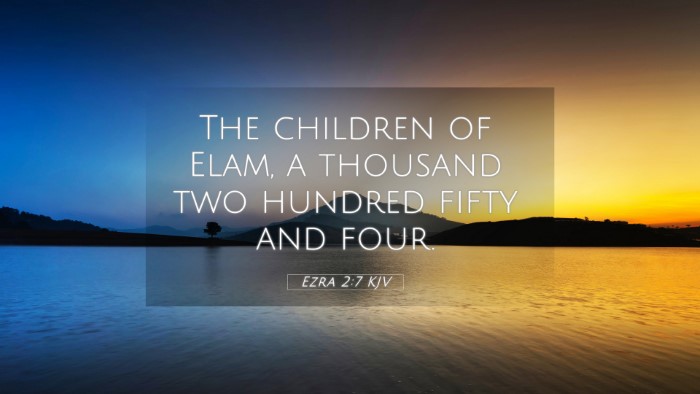Summary and Interpretation of Ezra 2:7
Ezra 2:7 presents a list of those who returned to Jerusalem from Babylonian exile, demonstrating God's faithfulness in restoring His people. This verse is crucial as it not only establishes the identity of the returning exiles but also signifies the beginning of a restoration process for the nation of Israel.
Contextual Overview
The book of Ezra details the return of the Jewish exiles and the rebuilding of the temple. The significance of Ezra 2:7 lies in its role within the broader narrative of restoration and hope. It highlights the importance of genealogies in the biblical text, serving to link the present community with their ancestral heritage.
Insights from Public Domain Commentaries
- Matthew Henry's Commentary:
Henry emphasizes that this list of families in Ezra 2:7 showcases God's providential guidance for His people. It establishes legitimacy and continuity among the returning exiles. This verse is a reminder that God knows and remembers His people, ensuring that they are not forgotten despite their long period of exile.
- Albert Barnes' Notes on the Bible:
Barnes discusses how this verse reflects a historical counting of those willing to return to their homeland. He points out the significance of each name, showing that every individual matters in God's plan. This genealogical record serves as evidence of God's covenant faithfulness to His people.
- Adam Clarke's Commentary:
Clarke highlights the collective identity of the returning exiles emphasized in Ezra 2:7. He notes that the specific mention of each family signifies inclusivity and invites reflection on the communal aspect of faith. The returning groups, listed numerically, underscore the restoration of the nation as a whole.
Bible Verse Cross-References
Ezra 2:7 can be cross-referenced with several Bible verses that enhance its understanding:
- Jeremiah 29:10: Reflects God's promise of restoration after exile.
- Nehemiah 7:7: Offers another account of those who returned, reinforcing the importance of community.
- Ezra 1:2-4: Describes the decree of Cyrus for the Jews to return to Jerusalem, fulfilling prophecy.
- Isaiah 43:5-6: Promises God's gathering of His people from nations, supporting the theme of divine restoration.
- Psalm 126:1: Joy expressed at the return from captivity, paralleling the themes in Ezra.
- Ezra 3:1: Details the unification of the returned exiles in rebuilding the altar, emphasizing community efforts in worship.
- Ezekiel 36:24: God’s promise to gather His people from among the nations, affirming the context of restoration.
Thematic Bible Verse Connections
Connections can be drawn between the returning exiles in Ezra 2:7 and other scripture passages that emphasize restoration and identity:
- Romans 11:1-2: Discusses God's unchanging nature towards His people.
- 1 Peter 2:9: Affirms believers as a chosen generation, echoing the restored identity seen in Ezra.
- Revelation 21:3: God's dwelling among His people, a promise indicative of divine restoration similar to that in Ezra.
Tools for Bible Cross-Referencing
For in-depth biblical analysis and exploration of cross-references like those found in Ezra 2:7, consider utilizing:
- Bible concordances
- Bible cross-reference guides
- Comprehensive Bible cross-reference materials
- Cross-reference Bible study methods
- Bible reference resources
Conclusion
In summary, Ezra 2:7 serves as a pivotal verse that not only lists the exiles returning to Jerusalem but also encapsulates themes of restoration, community, and divine faithfulness. Through cross-referencing with related biblical texts, one gains a deeper insight into the continuity of God’s promises and the collective identity of His people. A thorough understanding of Ezra 2:7 can enrich one's Bible study, particularly in recognizing connections between the Old and New Testaments, encouraging a holistic approach to scriptural interpretation.






